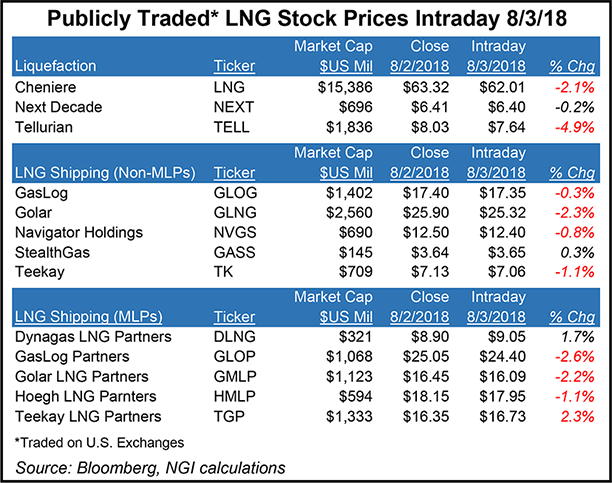Markets | Infrastructure | LNG | NGI All News Access | Regulatory
Opinions Divided on Impact China’s 25% Tariff Would Have on U.S. LNG
China said it will levy tariffs of up to 25% on $60 billion worth of U.S. products, including a 25% tariff on liquefied natural gas (LNG), if the Trump administration follows through with its threat to enact a 25% tariff on $200 billion worth of Chinese goods.

While representatives of the U.S. LNG industry warned the tit-for-tat tariffs could be detrimental, one analyst predicted the industry would not be affected in the short term, and that the long-term effects would hardly be a death knell. Rather, supply projects outside the United States may get another look.
In a translated statement, China’s Commerce Ministry accused the United States of “indiscriminately violating” World Trade Organization (WTO) rules, “further infringing on the legitimate rights and interests enjoyed by China in accordance with the rules of the WTO, and seriously threatening China’s economic interests and security.”
The Commerce Ministry released four lists of 5,207 products imported from the United States that would be subject to tariffs of 5%, 10%, 20% and 25%. LNG was on the 25% list.
‘A Tremendous Missed Opportunity’
Trade associations representing the U.S. LNG industry urged the Trump administration to quickly resolve the escalating trade dispute with China. Failure to do so, they warned, could force Beijing to look for LNG from other countries eager to do business.
“This move by the Chinese to add LNG to the list of possible retaliatory tariffs is an unwelcome but not wholly unexpected development,” said LNG Allies CEO Fred Hutchison. “It is imperative that the United States and China begin serious, high-level negotiations to resolve the complicated issues –which, by the way, are wholly unrelated to energy — that lie beneath the current tariff dispute.”
Center for LNG Executive Director Charlie Riedl concurred. “Tariffs, as we have said many times, are bad for consumers and producers alike,” he said. “The administration’s ‘energy dominance’ and ‘new energy realism’ agendas will cease to exist if one of the largest energy markets in the world is preemptively placing tariffs on LNG.”
Riedl said China has imported more than 185 Bcf of natural gas from the United States to date and is currently the third-largest buyer of U.S. LNG. He added that China has a growing appetite for LNG and is on track to become the world’s largest importer.

“Should these tariffs remain, China will source the LNG from other suppliers eager to fill the gap,” Riedl said. “This would be a tremendous missed opportunity and would have very real effects on the U.S. LNG industry.”
‘Plenty of Appetite’ From Other Buyers
Wood Mackenzie’s Giles Farrer, research director for global gas and LNG supply, said Chinese buyers would initially “bear the burden of the tariff because there is enough demand outside of China for U.S. LNG.” At the same time, he said “the impact on Chinese gas demand is likely to be limited as Chinese end user pricing is not related to LNG pricing.
“Therefore, on stream and under construction U.S. LNG would not be adversely affected. U.S. LNG, with a tariff, would become the marginal supply source into China. Chinese buyers could face a situation where non-U.S. suppliers, including portfolio players, could capture a larger margin if the Chinese buyer’s alternative includes the tariff. This would have knock-on impacts to the rest of the market.”
Farrer said there were likely to be “long-term market consequences” for new U.S. LNG supply projects — including the Alaska LNG Project — since the tariffs would give developers fewer options for securing long-term contracts. That said, “plenty of appetite exists from other buyers in Asia and Europe for a second wave U.S. LNG projects, [so] this is unlikely to be terminal. The first wave of U.S. LNG projects was successful despite not signing contracts with Chinese buyers.”
In a nod to efforts to build LNG terminals in western Canada, Farrer added the tariffs “could also support development of other projects outside of the U.S targeting the Chinese market, potentially allowing them to push for higher long-term contract prices.”
The escalating trade dispute with China appears to have already had an impact in Alaska. On Wednesday, the Alaska Journal of Commerce reported that China’s state-owned Sinopec Group is no longer being considered as a construction manager for the Alaska LNG Project. Sinopec, the Bank of China, China Investment Corp. and the Alaska Gasline Development Corp. signed a joint development agreement for the project last November.
According to Wood Mackenzie, for the 12-month period ending in June a total of 42 LNG cargoes were exported to China, roughly 3 million tonnes. All of the cargoes departed Cheniere Energy Inc.’s Sabine Pass terminal on the U.S. Gulf Coast. During those 12 months, China was the second-biggest export market for U.S. LNG, after South Korea. The firm said Royal Dutch Shell plc was the biggest supplier of U.S. LNG to China.
Beijing vowed to retaliate last month after the Trump administration proposed a 10% tariff on $200 billion worth of Chinese-made products. On Wednesday, the White House proposed increasing the tariff to 25%.
The office of U.S. Trade Representative Robert Lighthizer is taking public comments on the proposed tariffs until Aug. 17, and will hold a public hearing Aug. 20-23 at the U.S. International Trade Commission offices in Washington, DC. The tariffs could be enacted sometime after Aug. 30, the deadline for submitting post-hearing rebuttal comments to USTR.
© 2024 Natural Gas Intelligence. All rights reserved.
ISSN © 1532-1231 | ISSN © 2577-9877 |
